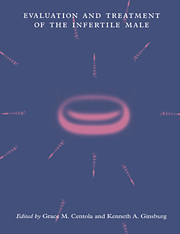Book contents
- Frontmatter
- Contents
- Preface
- List of contributors
- 1 Andrology
- 2 Sperm–egg interaction
- 3 Routine semen analysis
- 4 Computer-aided sperm analysis: a critical review
- 5 Antisperm antibodies: diagnosis and treatment
- 6 The sperm penetration assay
- 7 Intrauterine insemination for male factor
- 8 Processing human semen for insemination: comparison of methods
- 9 New assays for evaluating sperm function
- 10 Assisted reproductive technology for male factor infertility
- 11 Microinjection techniques for male infertility
- 12 Therapeutic donor insemination: screening, indications and technique
- 13 Endocrine assessment and hormone treatment of the infertile male
- 14 The urologic evaluation of the infertile male
- 15 Azoospermia: the diagnosis and treatment
- 16 White blood cells in semen and their impact on fertility
- 17 Psychological aspects of male infertility: lifting the shroud of shame
- 18 Evaluation of the female partner
- Index
18 - Evaluation of the female partner
Published online by Cambridge University Press: 16 September 2009
- Frontmatter
- Contents
- Preface
- List of contributors
- 1 Andrology
- 2 Sperm–egg interaction
- 3 Routine semen analysis
- 4 Computer-aided sperm analysis: a critical review
- 5 Antisperm antibodies: diagnosis and treatment
- 6 The sperm penetration assay
- 7 Intrauterine insemination for male factor
- 8 Processing human semen for insemination: comparison of methods
- 9 New assays for evaluating sperm function
- 10 Assisted reproductive technology for male factor infertility
- 11 Microinjection techniques for male infertility
- 12 Therapeutic donor insemination: screening, indications and technique
- 13 Endocrine assessment and hormone treatment of the infertile male
- 14 The urologic evaluation of the infertile male
- 15 Azoospermia: the diagnosis and treatment
- 16 White blood cells in semen and their impact on fertility
- 17 Psychological aspects of male infertility: lifting the shroud of shame
- 18 Evaluation of the female partner
- Index
Summary
Introduction
While approximately 40% of infertile couples will be found to have a male factor solely responsible or contributing to their infertility, couples in whom only the male partner has an infertility problem are less common. All couples presenting for fertility diagnosis and therapy require careful, coordinated evaluation of both partners. Optimally, this consideration of both partners should begin with the initial contact. The andrologist or urologist should establish a working relationship with a gynecologist or reproductive endocrinologist who can evaluate and treat the female partner. This evaluation should be initiated at the time the male partner is starting to undergo evaluation or early in the course of treatment, so that any factors operative in the female partner can be fully investigated and corrected as the male is reaching optimal fertility potential.
Three factors contribute to the majority of diagnosed fertility disorders in infertile couples. These include male factors, ovulatory abnormalities, and mechanical (organic) factors in a woman's reproductive tract. Evaluation and treatment of female factors comprises the remainder of this book. The ovulatory process, cervical and uterine function, patency of the fallopian tubes, and evaluation of the peritoneal environment to exclude endometriosis and pelvic adhesions comprise the major factors evaluated in the female. While many excellent texts and monographs have been written detailing the evaluation of the female partner, this chapter will review important steps in that evaluation with the goal of providing the andrologist/urologist with the understanding necessary to facilitate coordinated care of both partners.
- Type
- Chapter
- Information
- Evaluation and Treatment of the Infertile Male , pp. 297 - 313Publisher: Cambridge University PressPrint publication year: 1996



